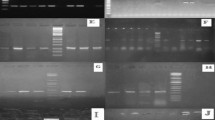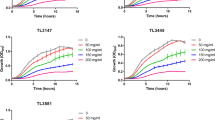Abstract
Pseudomonas aeruginosa was isolated from infected burn patients and characterized by standard biochemical tests. The in vitro copper uptake was compared between this isolated pathogenic strain and two non-pathogenic control strains of Gram positive bacteria Bacillusthuringiensis strain Israelis as well as Gram negative bacteria Enterobacter aerogenes. Maximum copper uptake of 470 ppm/g biomass was obtained by P. aeruginosa strain, while the control strains B. thuringiensis and Enterobacter aerogenes had copper uptake of 350 and 383 ppm/g biomass, respectively. However, the lowest copper uptake (60 ppm/g biomass) was observed with another control the saprophytic strain Pseudomonas (Shewanella) putrefaciens. A further investigation regarding the effect of copper toxicity on bacterial growth, gave an MIC score of 600 ppm for P. aeruginosa strain compared to 460 and 300 ppm for the two Gram positive and Gram negative control strains, respectively. In tandem with these in vitro findings, blood analysis on burn patients infected with P. aeruginosa has indicated a selective decrease of copper (hypocupremia) and ceruloplasmin plasma levels. The iron metabolism was also affected by this copper deprivation leading to a similar decrease in plasma levels of PCV, iron, total iron binding capacity, and transferrin. All these hematological changes were significantly different (P < 0.05) from the matched group of non-infected burn patients. The observed hypocupremia in infected burn patients was attributed to demanding scavenger ability by P. aeruginosa strain for the copper of plasma.





Similar content being viewed by others
References
Agay D, Anderson RA, Sander C, Bryden NA, Alonso A, Roussel AM, Chancerelle Y (2005) Alterations of antioxidants trace elements (Zn, Se, Cu) and related metalloenzymes in plasma and tissues following burn injury in rats. Burns 31:366–371
Barceloux DG (1999) Copper. J Toxicol Clin Toxicol 37:217–230
Berger MM (2006) Antioxidant micronutrients in major trauma and burns: evidence and practice. Nutr Clin Prac 21:438–449
Berger MM, Cavadini C, Bart A, Mansourian R, Guinchard S, Bartholdi I, Vandervale A, Krupp S, Chiolero R, Freeman J, Dirren H (1992) Cutaneous copper and zinc losses in burns. Burns 18:373–380
Bodey GP, Bolivar R, Fainstain V, Jadeja L (1983) Infections caused by Pseudomonas aeruginosa. Rev Infect Dis 5:279–313
Botzenhart K, Doring G (1993) Ecology and epidemiology of Pseudomonas aeruginosa. Plenum Press, New York, pp 1–18
Caille O, Rossier C, Perron K (2007) A copper-activated two-component system interacts with zinc and imipenem resistance in Pseudomonas aeruginosa. J Bacteriol 189:4561–4568
Chan S, Garson B, Subramanian S (1998) The role of copper, molybdenum, selenium, and zinc in nutrition and health. Clin Lab Med 18:673–685
Chen YS, Liu YC, Yen MY, Wang JH, Wang JH, Wann SR, Cheng DL (1997) Skin and soft-tissue manifestations of Shewanella putrefaciens infection. Clin Infect Dis 25:225–229
Chen X, Shi J, Chen Y, Xu X, Xu S, Wang Y (2006) Copper removal from aqueous systems: biosorption by Pseudomonas syringae. Can J Microbiol 52:308–316
Cooksey DA (1994) Molecular mechanisms of copper resistance and accumulation in bacteria. FEMS Microbiol Rev 14:381–386
Cox CD (1989) Importance of iron in bacterial virulence. Metal ions and bacteria. John Wiley & Sons, Inc, New York, pp 207–246
Dance DAB, Wuthiekanun V, Naigowit P, White NJ (1989) Identification of Pseudomonas pseudomallei in clinical practice: use of simple screening tests and API 20 NE. J Clin Pathol 42:645–648
Frieden E, Hsieh HS (1976) Ceruloplasmin: the copper transport protein with essential oxidase activity. Adv Enzymol Relat Areas Mol Biol 44:187–236
Gimis N, Safran ZB, Acarturk S, Abdilrezzak A (1999) Examination of serum zinc, copper, magnesium, and iron levels in patients with electric and flame scald burns. Ann Burns Fire Disasters 12:1–4
Hall C, Wales DS, Keane MA (2001) Copper removal from aqueous systems: biosorption by Pseudomonas syringae. Sep Sci Technol 36:223–240
Hussein H, Farag S, Kandil K, Moawad H (2005) Tolerance and uptake of heavy metals by Pseudomonas. Process Biochem 40:955–961
Khase S, Jande JM (1998) Biochemical and chemical properties of Shewanella alga and Shewanella putrefaciens. J Clin Microbiol 36:783–787
Khleifat K, Abboud MM (2003) Correlation between bacterial haemoglobin gene (vgb) and aeration. Their effect on the growth and α-amylase activity in transformed Enterobacter aerogenes. J Appl Microbiol 94:1052–1058
Klevay LM (2000) Cardiovascular disease from copper deficiency—a history. J Nutr 130:489S–492S
Larson DL, Maxwell R, Abston S, Dobrovsky M (1970) Zinc deficiency in burned children. Plast Reconstr Surg 46:13–21
Linder MC (1991) Biochemistry of copper. Plenum Press, New York
Linder MC, Hazegh-Azam M (1996) Copper biochemistry and molecular biology. Am J Clin Nutr 63:7975–8115
Lu ZH, Solioz M (2001) Copper-induced proteolysis of the Cop Z copper chaperone of Enterococcus hirae. J Biol Chem 276:47822–47827
McManus AT, Mason AD, McManus WF Jr, Pruitt BA Jr (1985) Twenty-five year review of Pseudomonas aeruginosa bacteremia in a burn center. Eur J Clin Microbiol 42:219–223
Nikadio H (1994) Prevention of drug access to bacterial targets: permeability barriers and active efflux. Science 264:382–388
Nikadio H (1996) Multidrug efflux pumps of Gram-negative bacteria. J Bacteriol 178:5853–5859
Ochsner A, Johnson Z, Vasil ML (2000) Genetics and regulation of two distinct haem-uptake systems in Pseudomonas aeruginosa. Microbiology 146:185–198
Olivares M, Uauy R (1996) Copper as an essential nutrient. Am J Clin Nutr 63:791S–796S
Pagani L, Lang A, Vedovelli C, Moling O, Rimenti G, Pristerà R, Mian P (2003) Soft tissue infection and bacteraemia caused by Shewanella putrefaciens. J Clin Microbiol 41:2240–2241
Pena MMO, Lee J, Thiele DJ (1999) A delicate balance: homeostatic control of copper up take and distribution. J Nutr 129:1251–1260
Percival SS (1995) Neutropenia caused by copper deficiency: possible mechanisms of action. Nutr Rev 53:59–66
Perron K, Caille O, Rossier C, van Delden C, Dumas J-L, Köhler T (2004) CzcR-CzcS. A two-component system involved in heavy metal and carbapenem resistance in Pseudomonas aeruginosa. J Biol Chem 279:8761–8768
Rasoloson D, Shi L, Chong CR, Kafsack BF, Sulivan DJ Jr (2004) Copper pathways in Plasmodium falciparum infected erythrocytes indicate an efflux role for the copper P-ATPase. Biochem J 381:803–811
Reeves PG, DeMars LCS (2005) Repletion of copper-deficient rats with dietary copper restores duodenal hephaestin protein and iron absorption. Exp Biol Med 230:320–325
Reid DW, Withers L, Francis NJ, Wilson JW, Kotsimbos TC (2002) Iron deficiency in cystic fibrosis: relationship to lung disease severity and chronic Pseudomonas aeruginosa infection. Chest 121:48–54
Robinson H, Monafo WW, Saver SM, Gallagher NI (1972) The role of erythropoietin in the anemia of thermal injury. Ann Surg 178:565–572
Schumann K, Classen HG, Dieter HH, Konig J, Multhaup G, Rukgauer M, Summer KH, Bernhardt J, Biesalski HK (2002) Hohenheim consensus workshop: copper. Eur J Clin Nutr 56:469–483
Shakespeare PG (1982) Studies on the serum levels of iron, copper, and zinc and the urinary excretion of zinc after burn injury. Burns 8:358–364
Shankowsky HA, Callioux LS, Tredget EE (1994) North American survey of hydrotherapy in modern burn care. J Burn Care Rehabil 152:143–146
Silver S (1996) Bacterial resistance to toxic metal ions—a review. Gene 179:9–19
Vivas A, Biró B, Ruíz-Lozano JM, Barea JM, Azcón R (2006) Two bacterial strains isolated from a Zn-polluted soil enhance plant growth and mycorrhizal efficiency under Zn-toxicity. Chemosphere 62:1523–1533
Voruganti VS, Klein GL, Lu HX, Thomas S, Freeland-Graves JH, Herndon DN (2005) Impaired zinc and copper status in children with burn injuries: need to re-assess nutritional requirements. Burns 31:711–716
Wallner S, Vautrin R, Katz J, Murphy J (1987) The anemia of thermal injury: partial characterization of an erythroid inhibitory substance. J Trauma 27:639–645
Yang CH, Menge JA, Cooksey DA (1993) Role of copper resistance in competitive survival of Pseudomonas fluorescens in soil. Appl Environ Microbiol 59:580–584
Author information
Authors and Affiliations
Corresponding author
Rights and permissions
About this article
Cite this article
Abboud, M.M., Saeed, H.A., Tarawneh, K.A. et al. Copper Uptake by Pseudomonas aeruginosa Isolated from Infected Burn Patients. Curr Microbiol 59, 282–287 (2009). https://doi.org/10.1007/s00284-009-9431-x
Received:
Revised:
Accepted:
Published:
Issue Date:
DOI: https://doi.org/10.1007/s00284-009-9431-x




